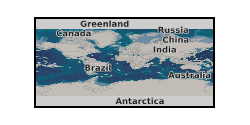Direct-shear experimental data on sedimentary gouge samples under high confining pressure and sliding velocity steps
This dataset contains raw experimental direct shear testing data as presented by "Ougier-Simonin, A., Castagna, A., Walker, R. J., & Benson, P. M. (2018). Frictional and mechanical behavior of simulated, sedimentary fault gouges. In AGU Fall Meeting Abstracts (Vol. 2018, pp. T11E-0212)". The data is provided in a .zip folder containing the files of 8 experiments that are accompanied by a README file for introduction. Files format is Microsoft Excel Worksheet (.xlsx) and data are tabulated. Each file contains the corresponding relevant sample’s details, and each column of data is clearly labelled, units included. For each experiment, time, axial force, axial displacement, axial stress, confining displacement, confining pressure, internal temperature, and axial delta P were recorded. Details of calculations for shear stress and coefficient of friction are also provided. Eight gouge (rock powder) samples of Monte Salici sandstone (Numidian Flysch, Appenninic-Maghrebian Chain; Sicily), ‘Comiso’ limestone (Ragusa Formation; Sicily) and Quaternary Clays (blue-grey clay in Fiumefreddo, Sicily) were tested in direct shear using sliding holders in triaxial compression at a confining pressure of 50 MPa. After 4 mm of axial (shear) displacement at 1 micron per second, variable rates of axial displacement were applied to induce velocity steps condition and measure rate-and-state parameters. Maximum displacement: ca. 9.8mm. All tests done at room temperature. The experiments were conducted by Drs A. Castagna and A. Ougier-Simonin using the MTS815 Rock Testing System in triaxial configuration and homemade sliding holders in the Rock Mechanics and Physics Laboratory of the British Geological Survey; both responsible for the collection and initial interpretation of the data. One test presented an issue on one of the signals recorded; the data are still shared for information purposes and the corresponding set of data is clearly named to indicate this fact.

non geographic dataset
:
http://data.bgs.ac.uk/id/dataHolding/13608107
English
Geoscientific information
GEMET - INSPIRE themes, version 1.0:
BGS Thesaurus of Geosciences:
Deformation (materials)
Quaternary
Shear strength
Carbonate rocks
Limestone
Physical properties
Sedimentary rocks
NGDC Deposited Data
Brittle deformation
Cohesion
Compression tests
Clays
Friction (engineering)
Sandstone
Free:
Free:
NERC_DDC
creation: 2023-09-19
2017-12-20
-
2018-03-29
University of Portsmouth
Philip Benson
Burnaby Building,
Portsmouth,
PO1 3QL
email:
not available
Role: originator
University of Leicester
Angela Castagna
email:
not available
Role: originator
University of Leicester
Richard Walker
email:
not available
Role: originator
British Geological Survey
Enquiries
Environmental Science Centre, Nicker Hill, Keyworth,
NOTTINGHAM,
NG12 5GG,
United Kingdom
tel: 0115 936 3143
email:
enquiries@bgs.ac.uk
Role: distributor
British Geological Survey
Enquiries
Environmental Science Centre, Nicker Hill, Keyworth,
NOTTINGHAM,
NG12 5GG,
United Kingdom
tel: 0115 936 3143
email:
enquiries@bgs.ac.uk
Role: originator
British Geological Survey
Enquiries
email:
not available
Role: distributor
British Geological Survey
Enquiries
email:
not available
Role: point of contact
Data Quality
Eight gouge (rock powder) samples of Monte Salici sandstone (Numidian Flysch, Appenninic-Maghrebian Chain; Sicily), ‘Comiso’ limestone (Ragusa Formation; Sicily) and Quaternary Clays (blue-grey clay in Fiumefreddo, Sicily) were tested in direct shear using sliding holders in triaxial compression at a confining pressure of 50 MPa. After 4 mm of axial (shear) displacement at 1 micron per second, variable rates of axial displacement were applied to induce velocity steps condition and measure rate-and-state parameters. Maximum displacement: ca. 9.8mm. All tests done at room temperature. The experiments were conducted by Drs A. Castagna and A. Ougier-Simonin using the MTS815 Rock Testing System in triaxial configuration and homemade sliding holders in the Rock Mechanics and Physics Laboratory of the British Geological Survey; both responsible for the collection and initial interpretation of the data. The datasets presented are the logging files as created between the 20th December 2017 and 29th of March 2018 with initial interpretations from Dr A. Castagna.
INSPIRE Implementing rules laying down technical arrangements for the interoperability and harmonisation of Geology
Commission Regulation (EU) No 1089/2010 of 23 November 2010 implementing Directive 2007/2/EC of the European Parliament and of the Council as regards interoperability of spatial data sets and services
Constraints
The copyright of materials derived from the British Geological Survey's work is vested in the Natural Environment Research Council [NERC]. No part of this work may be reproduced or transmitted in any form or by any means, or stored in a retrieval system of any nature, without the prior permission of the copyright holder, via the BGS Intellectual Property Rights Manager. Use by customers of information provided by the BGS, is at the customer's own risk. In view of the disparate sources of information at BGS's disposal, including such material donated to BGS, that BGS accepts in good faith as being accurate, the Natural Environment Research Council (NERC) gives no warranty, expressed or implied, as to the quality or accuracy of the information supplied, or to the information's suitability for any use. NERC/BGS accepts no liability whatever in respect of loss, damage, injury or other occurence however caused.
Available under the Open Government Licence subject to the following acknowledgement accompanying the reproduced NERC materials "Contains NERC materials ©NERC [year]"
licenceOGL
Metadata about metadata
05ef4bbe-1857-1dd2-e063-0937940a0b9d
British Geological Survey
Environmental Science Centre, Keyworth,
NOTTINGHAM,
NG12 5GG,
United Kingdom
tel: +44 115 936 3100
email:
enquiries@bgs.ac.uk
Role: point of contact
2024-04-24
